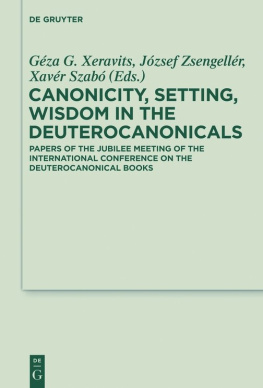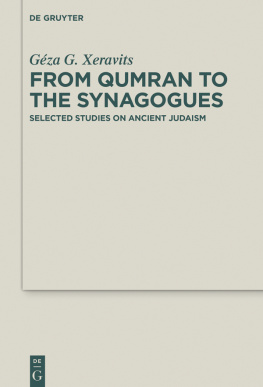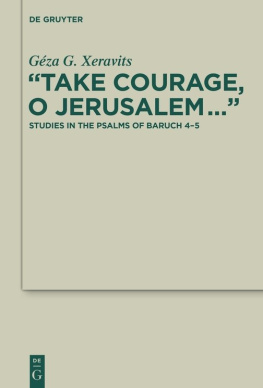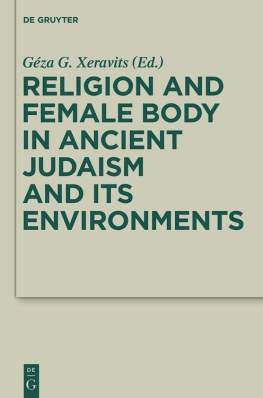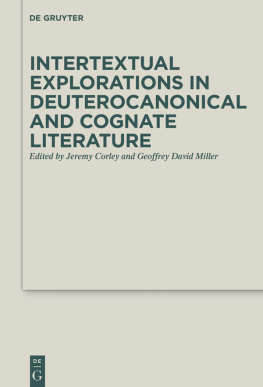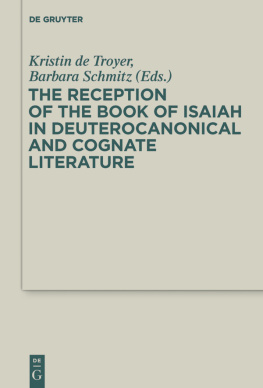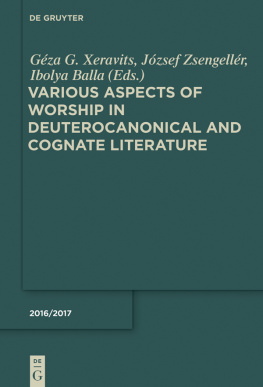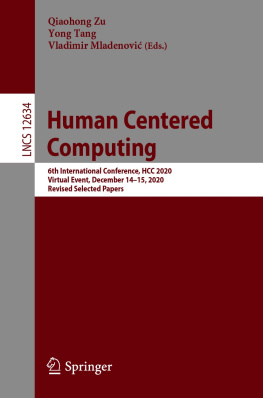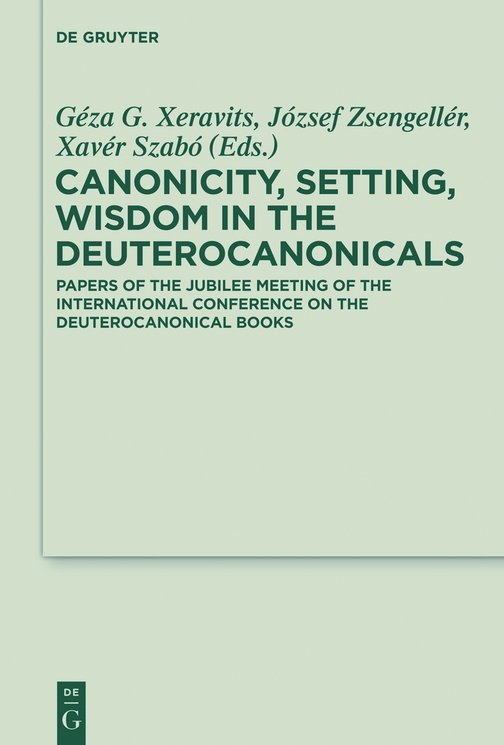The Penumbra of the Canon What Do the Deuterocanonical Books Represent?
JOHN J. COLLINS
The Deuterocanonical writings (Tobit, Judith, Ben Sira, Wisdom of Solomon, 1-2 Maccabees, Baruch, plus the additions to Daniel and Esther) owe their existence as a category to the Council of Trent (1546) and the polemics of the Reformation era. The Protestant reformers had adopted Jeromes principle of Hebraica veritas , and acknowledged only the books found in the Hebrew Bible as inspired scripture in the Old Testament. The Council reacted by affirming the larger canon of the traditional Catholic Church:
If any one receive not, as sacred and canonical, the said books entire with all their parts, as they have been used to be read in the Catholic Church and as they are contained in the old Latin Vulgate... let him be anathema.
The designation Deuterocanonical is attributed to Sixtus of Siena (1520-1569), in recognition of the fact that their canonicity was disputed. B.F. Westcott scathingly remarked a few centuries later:
This decree of the Council of Trent was ratified by fifty-three prelates, among whom there was not one German, not one scholar distinguished by historical learning, not one who was fitted by special study for the examination of a subject in which the truth could only be determined by the voice of antiquity.
In fact, the Council Fathers relied on tradition from the age of Augustine, when councils at Hippo (393 CE) and Carthage (397 CE) had affirmed the larger canon, which had also been endorsed at the Council of Florence in 1442 as the basis of union between Rome and the Coptic Christians. The Tridentine canon was identical to the list issued by the Council of Hippo, except that the Council Fathers appear to have misunderstood the meaning of 1 and 2 Esdras, which they identified as the proto-canonical books of Ezra and Nehemiah. The omission of 2 Esdras was significant, as it deprived the Catholic Bible of a major apocalypse, and also of a book for which the primary text was not Greek but Latin.
The disagreement between Catholics and Protestants in the Reformation era reflected much older disputes in the early Church. When Melito of Sardis was asked for an accurate statement of the ancient books in the late second century CE, he had to send to Palestine for an answer. His list is confined to the Hebrew canon, but without Esther. Others were more inclusive. Tertullian was aware that the Book of Enoch was not accepted by the rabbis, but argued nonetheless: since Enoch by the same scripture has also made proclamation concerning the Lord, nothing whatever must be rejected by us which pertains to us ( On Womens Dress 1.3). Clement of Alexandria cited Tobit, Sirach and the Wisdom of Solomon as Scripture, and Judith and 2 Maccabees as historical sources. Origen accepted Susanna as part of the text of Daniel, although he knew it was not in the Hebrew, because Susanna is found in every church of Christ. Tobit could not be used in disputation with Jews, but could within the churches ( Letter to Africanus 13).
The popular use of the codex in early Christianity was an important factor in the definition of a canon. The great fourth century codices, Vaticanus and Sinaiticus include the books of Tobit, Judith, Ben Sira (Ecclesiasticus), the Wisdom of Solomon. Sinaiticus further includes 1 and 2 Maccabees, and the fifth century Codex Alexandrinus adds 3-4 Maccabees and the Psalms of Solomon.
Athanasius and Jerome recognized only the 22 books of the Hebrew canon (counting the Book of the Twelve as one, and combining 1-2 Samuel, 1-2 Kings, 1-2 Chronicles, Ezra-Nehemiah, Jeremiah-Lamentations, and Ruth-Judges, so the 22 books are counted as 39 in modern Christian Bibles). Yet Jerome translated the additional books as well, although he distinguished them as apocryphal in his prefaces. Since the prefaces were not always copied or heeded, the Western church came to regard all the books of the Vulgate as part of Scripture.
St. Augustine had a decisive influence on the western church. He listed 44 books, but included Lamentations and Baruch as parts of Jeremiah. The Gelasian Decree at the end of the fifth century recognized Tobit, Judith, the Wisdom of Solomon, Sirach, 1-2 Maccabees and the additions to Esther, Daniel and Jeremiah. The Tridentine fathers, then, could claim the support of a long, if not quite consistent, tradition.
A Canon in Judaism?
In general, however, the Dead Sea Scrolls have complicated rather than clarified our picture of authoritative scriptures in Judaism around the turn of the era. On the one hand, there was considerable textual variation in the admittedly authoritative Torah, and there is some question as to whether a book like the Temple Scroll would have been regarded, by some people, as Torah. On the other hand, there was a much larger corpus of writings in circulation than was previously known. These included prophetic or pseudo-prophetic works ascribed to Ezekiel, Jeremiah and Daniel, but also wisdom compositions and halachic texts. Some works that did not eventually become part of the Hebrew canon, such as the books of Enoch and Jubilees, appear to have been viewed as authoritative by the people who collected the Scrolls. Remarkably, however, the only Deuterocanonical books found at Qumran are Tobit, which is attested in both Hebrew and Aramaic, Ben Sira, of which Hebrew fragments were found at both Qumran and Masada, and the Letter of Jeremiah, of which a small Greek fragment was found.
For a long time it was assumed that the larger collection of Greek and Latin scriptures reflected the canon of Alexandrian Judaism. The idea that Alexandrian Judaism had a distinct canon was debunked by Albert C. Sundberg in his 1964 book on The Old Testament of the Early Church . It is clear from the testimony of Philo that the Torah, or Pentateuch, was the primary scriptural authority. The prologue to Ben Sira and 2 Maccabees also acknowledge the prophets, but while these were written in Greek they may well reflect Judean rather than Alexandrian views. Many of the writings that survive from Egyptian Judaism either bear the names of their actual authors or were written under Gentile pseudonymns, and consequently were not likely to be considered as scripture. According to Philo, the Therapeutae had a consecrated room into which they took nothing but laws and oracles delivered through the mouth of prophets and psalms and anything else which fosters and perfects knowledge and piety. This corresponds quite well to the prologue to Ben Sira. The Law and the Prophets were well known categories (even if the text and contents were still open to some debate) but the third category of other writings was fluid. It is to this third category that the Deuterocanonical writings belong.
It is apparent, then, that the notion of canon, in the sense of a fixed list of authoritative scriptures, is anachronistic for Judaism in the Second Temple period. Rather, in the words of John Barton,
Only at the end of the first century CE do we find authoritative books limited to a specific number. In his tract Against Apion , Josephus writes: we do not possess myriads of inconsistent books, conflicting with each other. Our books, those which are justly accredited, are but two and twenty, and contain the record of all time ( Ag.Ap . 1:37-39). He goes on to specify the 22 books as the five books of Moses, 13 books of the prophets, and four books containing psalms and precepts. The prophets are said to have written the history of the events in their own times. This category incorporated what we could call the historical books, including probably Esther and Job, and surely included Daniel. Josephus was concerned with these books as reliable historical sources, but he implies that they are also reliable guides to life. His argument is obviously an apologetic one. The books may not be myriad, but they were surely not consistent. He does not acknowledge, in this passage, the existence of other Jewish books besides these, but he makes demonstrable use of 1 Esdras and 1 Maccabees in his histories, and also of the Letter of Aristeas , which was never regarded as canonical. The statement about the 22 books presumably reflects some current, authoritative, opinion, but it does not reflect his own practice. Steve Mason infers that he did not regard these later books as equal in authority to the 22, He felt no obligation to limit himself to the twenty two books or to regard all other Jewish books as unreliable.

